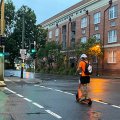It was her volunteering spirit that kept Kate Morioka from accepting a multicultural award from Premier Peter Beattie at Parliament House on May 12.
Ms Morioka had won Outstanding Young Achiever in the Queensland Multicultural Awards but the full-time social planner, university student and keen community volunteer, couldn’t make it.
She was in Samoa running a Pacific youth summit and helping youth leaders from 14 Pacific islands write a Pacific Youth Declaration and Youth Statement.
The 23-year-old from Redcliffe, who describes herself as half-Japanese, half-Taiwanese, won the Queensland Government award for her community involvement and volunteering.
As a senior social planner with the Maroochy Shire Council, she helps plan social networks and makes sure communities are consulted before developments.
On weeknights and weekends, she works on her thesis for her Masters of Social Planning and Development degree at The University of Queensland.
She also volunteers for many welfare projects run by the United Nations (UN) Student Association, Youth for a Sustainable Future Network, the UN Association of Australia, Redcliffe Rotary, Red Cross, the Paraplegic and Quadriplegic Association of Queensland and the James Ommaney Retirement Village.
She had also previously cared for her dad who has dementia and grandfather who has Alzheimer’s.
“Being multicultural is part of who I am and I encourage others to celebrate cultural diversity,” Ms Morioka said.
While in Samoa, Ms Morioka enlisted the villagers of Solosolo, outside the Samoan capital, to map their important cultural sites for her degree.
Using tracing paper, the villagers drew their territories, valuable resources, land uses, water sources and socio-economic data over an aerial map of Solosolo.
Ms Morioka said the data could be digitized using geographical information systems and analysed in combination with existing scientific data such as topography, soil and vegetation type.
She said she wanted to show how communities rather than technical experts could use spatial technology for protecting their land and resources.
She chose to study Samoa because she had worked there before on a United Nations youth project and because Samoa’s planning laws were advanced, compared to the rest of the Pacific.
Media: Ms Morioka (0431 108 560, morioka_k@hotmail.com) or Miguel Holland at UQ Communications (3365 2619)
.jpg)


